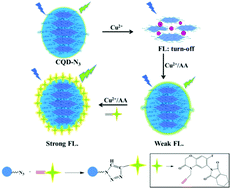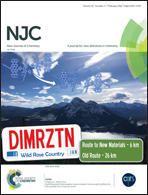A novel carbon quantum dot-based fluorescent nanosensor for selective detection of flumioxazin in real samples†
Abstract
Herein, a carbon quantum dot-based highly selective luminescent probe has been designed for the detection of the pesticide flumioxazin via the alkyne azide click reaction. An azide (N3)-functionalized QD has been synthesized by conjugating 4-azidoaniline on the surface of the CQD by carbodiimide coupling. The turn-on fluorescence of the probe upon the addition of flumioxazin is attributed to the formation of a triazole-functionalized CQD in the presence of Cu(II) and ascorbic acid. The sensing protocol was also successfully validated in a number of compounds containing alkynyl groups. The fluorescence increase factor for flumioxazin (F/F0) works linearly in the concentration range 0–35.4 μg l−1, and the limit of detection is found to be 0.027 μg l−1. The specific recognition of alkynyl groups towards azide in the presence of Cu(II) makes our probe specific and selective towards flumioxazin even in the presence of other pesticides. The utility of the developed sensor has also been explored in real agricultural samples.



 Please wait while we load your content...
Please wait while we load your content...